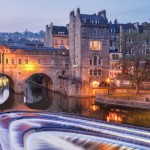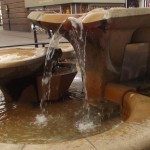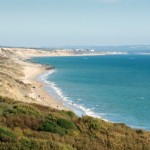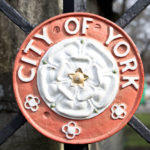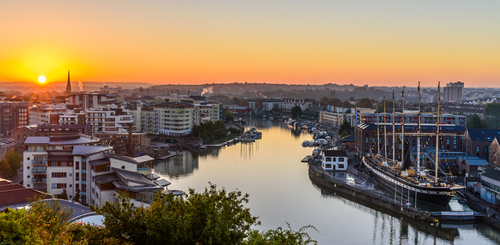
Bristol, home to SS Great Britain, a place full of stunning architecture, and the holder of a market with over 40 traders that sell everything from crafts to flowers to jewellery. The food industry in Bristol is simply stunning, with hundreds of restaurants and cafés that serve food from across the world. And, of course, there’s also Harbourside, which has its own aquarium, architecture centre, and plenty of tours.
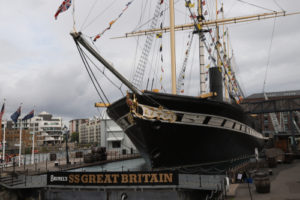
Seafarer or landlubber a tour of the SS Great Britain shouldn’t disappoint
This English city is a historical paradise, perfect for weekend breaks or day visits, no matter the age of the people visiting. It’s family-friendly, great for couples, and even amazing for solo travellers or tourists who are just looking for a bite of history. But there’s so much more to this city than we’ve covered already! Jump straight into our guide to Bristol below.
History of Bristol!
Bristol began as a simple village by the name of “Brigg Stow”, with a bridge that was used as a meeting place by many. Over time, the village’s name changed, and it started to become the Bristol we know today.
By the 10th century, Bristol grew from a village into a town. By the 11th century, it became a place of importance, used to trade in wool and leather. The 12th century was a time when King William’s wooden fort was rebuilt as a stone castle, and Bristol was given a charter to give more rights to its townspeople.
By the 13th century, wine was the main import coming and going from the city of Bristol; as well as woad, which was used for dyeing. Like many other cities in England during the Medieval period, Bristol was used as a place to weave and dye wool, which was then exported to other places. Bristol was also a town full of carpenters, blacksmiths, brewers, bakers, and more! The Middle Ages saw merchants bring a red flower called the scarlet lychnis from the eastern Mediterranean. This flower became the emblem of Bristol.
Between the years 1239 and 1247 the course of the Frome was changed to make navigation easier. The newly constructed channel was more than 700 meters long and it cost £5,000 to build; which was a huge amount of money during that time. At an average inflation of 0.9% a year, that would be almost 8 million pounds today.
Tudor Times
The main exports of Bristol during the Tudor times changed from their original products. Then, Bristol traded in more animal-based products, as well as tin. The cloth and wool industries declined. The 17th century saw outbreaks of the plague, the founding of the Queen Elizabeth Hospital School, the Red Maids Girls’ School, and the Red Lodge.
Bristol castle was ordered destroyed during the civil war, and despite the fighting, Bristol recovered and bloomed. Tobacco and sugar trades, a new glass industry, shipbuilding, and even chocolate (once Georgian times hit). By 1801 Bristol had a population of 68,000.
By 1841, the railway connected Bristol to London. Then Exeter in 1844, Plymouth in 1848, and Clifton suspension bridge was built in 1864. Aircrafts came later, in the 20th century; becoming the greatest industry in Bristol.
Bristol still flourishes today, with tourism being a huge industry. The 21st century has brought many new attractions to the city.
What to do in Bristol!
One of the world’s great bridges hangs over Bristol. The Clifton Suspension Bridge has been open since 1864, and is manned 24 hours a day, seven days a week. For over one hundred years, this Grade I structure has guarded the skies above Avon Gorge; a symbol of Bristol and all it stands for. Connecting both sides and allowing people and cars to pass over it. Crossing the bridge is free for pedestrians and cyclists, while it costs just £1 for motor vehicles to go across.
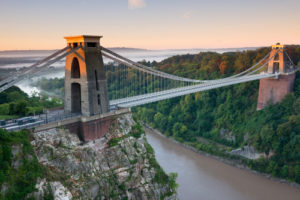
The iconic Clifton Suspension Bridge – for engineering types the free museum is well worth a visit!
The Bridge is just one of many attractions in Bristol; this south western city has its own unmistakable identity, and there is plenty to do here. See some of our suggestions for shopping, places to eat, and places to go in the next few sections of this article.
Shopping
The very heart of the city of Bristol is the grounds for Bristol Shopping Quarter. A place filled from street to street with hundreds of stores, including high street favourites and amazing restaurants. But, for the purposes of this section, we’ll just focus on the shops in Bristol. There are independent boutiques, the Galleries (a shopping centre in the Quarter), and lots of chain stores that you’ll recognise from just about any city or town in England.
Bristol Markets are also a great place to visit. There are several weekly markets that sell local produce that has been picked directly from South Gloucestershire and Somerset, as well as more exotic produce imported from other countries of the world.
Park Street and Greens Road is another beautiful shopping area. Park Street is a Georgian street, where there is a number of trendy boutiques, record stores, bars and restaurants. A paradise for dedicated Instagram users to test their photography skills.
Next on our list of amazing places to shop is Wapping Wharf. Located in Harbourside, you can shop and relax right by the waterfront. Similarly, Clifton Village has a few upmarket and independent retailers that sell products of the handmade homeware variety.
Lastly, why not give Cabot Circus a try? This is a shopping centre within the Bristol Shopping Quarter that is designed in a unique way. It’s a building that looks more like a piece of modern art.
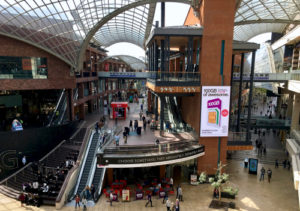
Architectural impressive – Cabot’s Circus Shopping Centre
Food and Drink
Other than London, Bristol has the most Michelin stars in the UK. We’ve listed a few of our favourites for your inevitable trip to this great City:
Root and Box-E are located right next to each other in the Wapping Wharf of Bristol. Root is all above creative and delicious uses of various vegetables, while Box-E offers rustic dishes and an infamous panna cotta.
Bulrush is the most recent Bristol restaurant to receive its own Michelin star, and it’s obvious that this place of well-crafted and well-seasoned dishes deserves that award. Bulrush has been feeding customers since 2015 and can be found on Cotham Road right near the University of Bristol.
Away from the fancier places, there are plenty of pubs and bars in Bristol that are happy to have your business. The south west of England is pretty well-known for cider and beer, and Bristol is no different. There are some perfect and cosy places to go in Bristol that have fine selections of ciders and beers. The Barley Mow, just behind Temple Meads, offers 18 different beers to compliment its menu.
The Cottage Inn, with views that overlook the harbour, has its own sister pub at the opposite end of the harbour; that being The Ostrich. Both are definitely worth a visit if you prefer homelier places to spend your afternoon.
Vegans, rejoice! Bristol has plenty of restaurants for you, too. Widely known as the world’s capital for vegan food, thanks to a recent survey, there’s everything from vegan pies to national cuisine for you to enjoy. We’ve already mentioned Root, but Fi Real and Oowee Vegan are both great for vegan and vegetarian food, too.
Music and Entertainment
Bristol has a very varied music scene, and there’s plenty of live entertainment. From The Fleece to the O2 Academy, Bristol brings thousands of artists from across the world to the venues in its city borders.
For classical concerts, dive inside St. George’s Bristol or Colston Hall. Lovers of the history of music will benefit from a trip to Trinity Centre, which is known as the birthplace of the Bristol Sound from the late 1980s. All three of these older venues have been playing music for years, and there’s a huge community surrounding them.
Now, if you’re simply looking to be entertained, Bristol has plenty of attractions. Bristol is the best centre to explore the natural attractions of this part of England. The Redcliffe Caves await you, as does Clifton Rocks Railway, the Bristol Observatory, Cabot Tower and even Durdham Downs, not forgetting the Clifton Suspension Bridge that we mentioned earlier.
There’s an abundance of live performances, new bands, animal farms, walking tours, and so much more to see and do. And there’s always the SS Great Britain, as well, if you have the time in your packed schedule!
Travelling in Bristol!
Travelling around Bristol couldn’t be made any easier than it already is. Cycling is a huge thing in Bristol; the first cycling capital of the UK. There are tonnes of cycle paths and bike hires around the city if you don’t fancy walking for a long period of time.
Public transport is everywhere, too. Buses, trains, boats, and park and rides. For the bus, you’ll be pleased to know that Bristol is run by the ever-reliable First Group, whose prices are largely the same anywhere in England. Expect to pay approximately £4 to get around the city for the day, or just over £5 if you want to travel within the network but outside of the main areas. Metrobus also caters to Bristol, offering a fast and environmentally friendly way of travelling around the city. You can also buy tickets before you board the bus; as ticket machines for Metrobus buses are available at every stop.
Bus and a bus tour in one? Take a ride on an open top bus through the Bristol Insight company and let the driver tell you all about every sight you come across. Tickets for these journeys are readily available at the Tourist Information Centre.
Many major train companies run through Bristol, with it being a starting and ending point on a few travel lines. Bristol Temple Meads can be accessed from Cardiff, London, and Edinburgh; just to name a few.
We also briefly mentioned boats! Number Seven Boats and Bristol Ferry Boats regularly sail around the waterfront, and Avon River Cruises offer private trips with on-board catering.
Places to stay in Bristol!
Berwick Lodge, a picturesque mansion-like accommodation with ornate rooms and a superb garden. Around £100 a night, you’ll benefit from a salon, a bar with brilliant staff members, and an elegant dining room. A 5-star hotel for guests looking for a little extra.
You can even find a Holiday Inn, a Travelodge, and even a Novotel hotel. Next to Bristol Temple Meads, if you don’t want to be too far away from the main train station, Holiday Inn Express averages around £55 a night, or Novotel is around £57. Near to both of these is a Hilton branded hotel, too.
As for the all-popular Air Bnbs, you can find a lodge on a lake, an eco-cabin, modernised barns, and apartments in Bristol; all just waiting for you to stay in. The average AirBnB will cost a similar amount to the budget hotels we’ve listed in the above paragraph, while some may cost less and more unique ones may cost more.
Editorial Credit: Shutterstock.com for all photos and images
